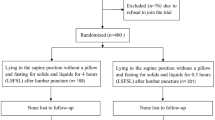Abstract
The purpose of the study was to evaluate patient outcomes, including success rates, factors associated with unsuccessful procedures and frequency of post-lumbar puncture headaches (PLPH), at a dedicated academic outpatient lumbar puncture (LP) clinic. All patients referred to our LP clinic between June 1, 2014 and May 31, 2015 were included in this consecutive observational series. We collected information about patient characteristics, operational parameters of the procedure, and complications. We also recorded rates of participation in biomedical research involving use of cerebrospinal fluid. Univariate analysis used Student’s t test and Fisher’s exact test. Logistic regression was used to determine independent risk factors associated with unsuccessful LP and PLPH. The mean age of patients referred to our LP clinic was 46 ± 17 years. Of the 307 referrals, 281 patients (92%) started the procedure, with successful acquisition of CSF in 267 (95%). Factors contributing to unsuccessful procedures included higher body mass index [odds ratio (OR) 1.8], older age (OR 1.9), and female sex (OR 10.3). The rate of PLPH was 5.7%. Younger age (OR 0.5), female sex (OR 6.9), high mean arterial pressure (OR 2.2), and a traumatic LP (OR 10.0) were identified as risk factors for PLPH. Notably, 202 patients (72%) consented to biomedical research. A standardized approach to outpatient LP demonstrates high procedural success rate, low PLPH rate, and high participation in biomedical research. Awareness of a group of patients at higher risk for complications including procedure failure or PLPH provides guidance for decision-making regarding referral to the outpatient LP clinic.
Similar content being viewed by others
References
Ellenby MS, Tegtmeyer K, Lai S et al (2006) Lumbar puncture. N Engl J Med 355:e12. doi:10.1056/NEJMvcm054952
Shah KH, Richard KM, Nicholas S et al (2003) Incidence of traumatic lumbar puncture. Acad Emerg Med 10(2):151–154
Eskey CJ, Ogilvy CS (2001) Fluoroscopy-guided lumbar puncture: decreased frequency of traumatic tap and implications for the assessment of CT-negative acute subarachnoid hemorrhage. AJNR Am J Neuroradiol 22:571–576
Sahin SH, Colak A, Arar C et al (2014) Modified 45-degree head-up tilt increases success rate of lumbar puncture in patients undergoing spinal anesthesia. J Anesth 28(4):544–548
Edwards C, Leira EC, Gonzalez-Alegre P (2015) Residency training: a failed lumbar puncture is more about obesity than lack of ability. Neurology 84(10):e69–e72
Halpenny D, O’Sullivan K, Burke JP et al (2013) Does obesity preclude lumbar puncture with a standard spinal needle? The use of computed tomography to measure the skin to lumbar subarachnoid space distance in the general hospital population. Eur Radiol 23(11):3191–3196
Leibold RA, Yealy DM, Coppola M et al (1993) Post-dural puncture headache: characteristics, management, and prevention. Ann Emerg Med 22:1863–1870
Evans RW, Armon C, Frohman EM et al (2000) Prevention of post-lumbar puncture headaches. report of the therapeutics and technology assessment subcommittee of the American Academy of Neurology. Neurology 55(7):909–914
Dakka Y, Warra N, Albadareen RJ et al (2011) Headache rate and cost of care following lumbar puncture at a single tertiary care hospital. Neurology 77(1):71–74
Zetterberg H, Tullhog K, Hansson O et al (2010) Low incidence of post-lumbar puncture headache in 1,089 consecutive memory clinic patients. Eur Neurol 63(6):326–330
Engedal TS, Ording H, Vilholm OJ (2015) Changing the needle for lumbar punctures: results from a prospective study. Clin Neurol Neurosurg 130:74–79
Grände P-O (2005) Mechanisms behind postspinal headache and brain stem compression following lumbar dural puncture—a physiological approach. Acta Anaesthesiol Scand 49(5):619–626
Kaplan G (1967) The psychogenic etiology of headache postlumbar puncture. Psychosom Med 29(4):376–379
Zeidan A, Farhat O, Maaliki H et al (2006) Does postdural puncture headache left untreated lead to subdural hematoma? Case report and review of the literature. Int J Obstet Anesth 15(1):50–58
Tung CE, So YT, Lansberg MG (2012) Cost comparison between the atraumatic and cutting lumbar puncture needles. Neurology 78(2):109–113
Monserrate AE, Ryman DC, Ma S et al (2015) Factors associated with the onset and persistence of post-lumbar puncture headache. JAMA Neurol 72(3):325–332
Acknowledgements
We thank the residents, staff, and patients of the Johns Hopkins LP clinic. We are grateful for the support provided by The Bart McLean Fund for Neuroimmunology Research and Johns Hopkins Project RESTORE.
Author information
Authors and Affiliations
Contributions
PB: data collection, data analysis and interpretation, and writing; DRB: data interpretation and writing; JFB: statistical analysis; CAP: data interpretation and manuscript review; AJ: data collection and data interpretation; RF: data interpretation and writing; MNB: study design, data collection, data interpretation, writing, and project oversight.
Corresponding author
Ethics declarations
Conflicts of interest
Dr. Paula Barreras, Dr. David R. Benavides, Mr. Jorge F. Barreras, Dr. Carlos A. Pardo, Ms. Ami Jani, Dr. Roland Faigle, and Dr. Mona N. Bahouth have nothing to disclose.
Ethical standards
This study was approved by the Johns Hopkins Institutional Review Board and has therefore been performed in accordance with the ethical standards laid down in the 1964 Declaration of Helsinki and its later amendments.
Rights and permissions
About this article
Cite this article
Barreras, P., Benavides, D.R., Barreras, J.F. et al. A dedicated lumbar puncture clinic: performance and short-term patient outcomes. J Neurol 264, 2075–2080 (2017). https://doi.org/10.1007/s00415-017-8597-6
Received:
Revised:
Accepted:
Published:
Issue Date:
DOI: https://doi.org/10.1007/s00415-017-8597-6




